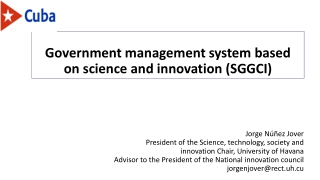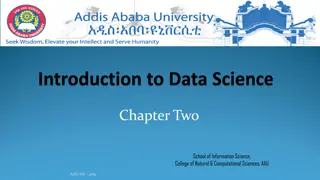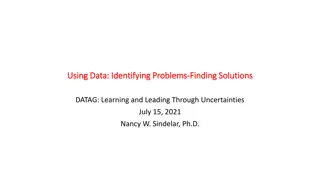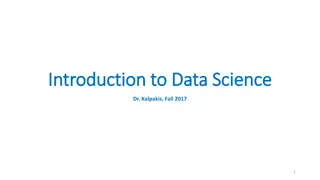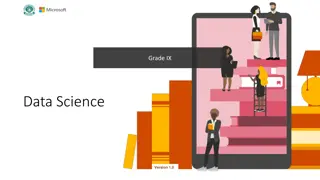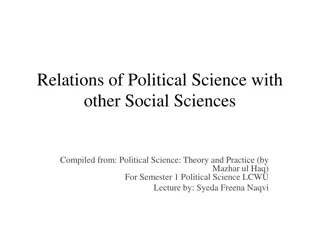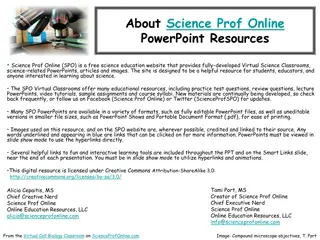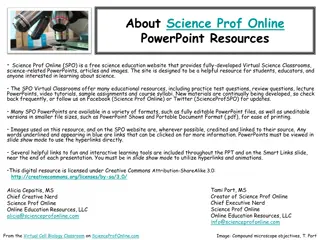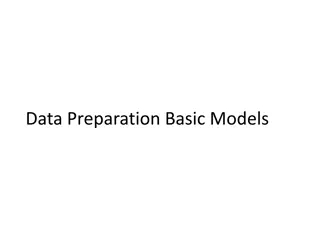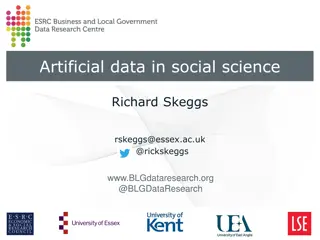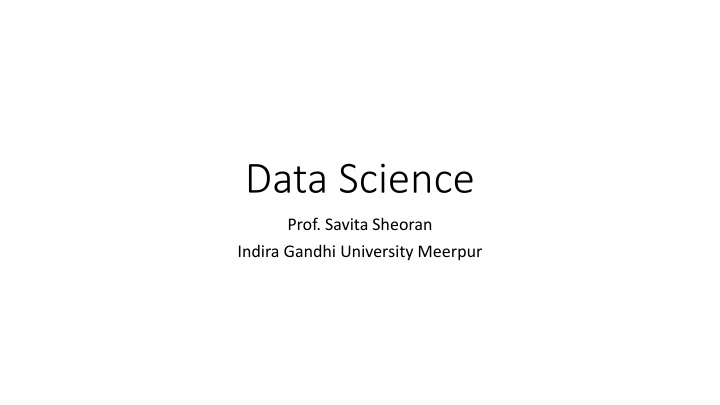
Data and Information Processing
Explore the significance of data and information in the realm of data science. Learn about the raw facts of data, the transformation into meaningful information, types of information, and the crucial distinction between data and information. Discover the essence of data science and its impact on modern technologies and decision-making processes.
Download Presentation

Please find below an Image/Link to download the presentation.
The content on the website is provided AS IS for your information and personal use only. It may not be sold, licensed, or shared on other websites without obtaining consent from the author. If you encounter any issues during the download, it is possible that the publisher has removed the file from their server.
You are allowed to download the files provided on this website for personal or commercial use, subject to the condition that they are used lawfully. All files are the property of their respective owners.
The content on the website is provided AS IS for your information and personal use only. It may not be sold, licensed, or shared on other websites without obtaining consent from the author.
E N D
Presentation Transcript
Data Science Prof. Savita Sheoran Indira Gandhi University Meerpur
Data Data refers to raw facts, figures, or information that can be collected, analyzed, and processed to derive insights, make decisions, or solve problems. It can come in various forms, such as numbers, text, images, audio, or other types of information, and it is often organized into structured or unstructured formats. Data by itself may not be immediately meaningful until it is interpreted or analyzed within a specific context.
Information Information Information is data that has been processed or organized in a way that becomes meaningful and useful to individuals. It refers to facts, knowledge, or data that can help inform decisions, actions, or understanding. Information can be communicated through various formats, such as text, numbers, images, and sounds.
Types of Information Factual Information: Objective and verifiable details, such as historical data or scientific facts. Conceptual Information: Abstract ideas or theories. Descriptive Information: Accounts or explanations of a phenomenon. Procedural Information: Instructions or steps on how to perform a task.
Data vs. Information Data vs. Information: Data are raw facts, figures, or symbols without context. For example, a list of numbers or words without explanation. Information is processed data that is meaningful. For example, if those numbers represent a person s age, salary, and job title, they John is a 25-year-old person living in New York. Raw Data: "John, 25, New York"
WHY DATA SCIENCE? We have run out of adjectives and superlatives to describe the growth trends of data. The technology revolution has brought about the need to process, store, analyze, and comprehend large volumes of diverse data in meaningful ways. However, the value of the stored data is zero unless it is acted upon. The scale of data volume and variety places new demands on organizations to quickly uncover hidden relationships and patterns. This is where data science techniques have proven to be extremely useful. They are increasingly finding their way into the everyday activities of many business and government functions, whether in identifying which customers are likely to take their business elsewhere, or mapping flu pandemic using social media signals
Data Science Data Science There s a joke that says a data scientist is someone who knows more statistics than a computer scientist and more computer science than a statistician. Data science is a collection of techniques used to extract value from data. It has become an essential tool for any organization that collects, stores, and processes data as part of its operations. Data science, known as data-driven Science, is an interdisciplinary field of scientific methods, processes, and systems to extract knowledge or insights from data in various forms, either structured or unstructured, similar to data mining. Data science is one of the recent fields Combining big data, unstructured data, and a combination of statistics, analytics and business intelligence. It is a new field that has emerged within the field of data management providing an understanding of the correlation between structured and unstructured data.
Cont. Cont. Data Science is a discipline of using quantitative methods from statistics and mathematics along with technology( computer and software) to develop algorithms designed to discover patterns, predict outcomes, and find the optimal solution to complex problems. Data science is blossoming as a concept to unify statistics, data analysis, and their related methods in order to understand and analyze actual phenomena with big data.
Cont.. It is an extended canvas (while dealing with big data) data science uses techniques and theories drawn from many fields within the broad area of mathematics, statistics, information science and computer science in particularly from the sub domains of machine learning, classification, cluster analysis, data lakes data mining and warehousing, databases and visualization. Turning award winner , Jim Gray imagined data science as a fourth paradigm of science (empirical, theoretical, computational, and now data-driven) and asserted that everything about science is changing because of the impact of information technology and the data deluge.
Terminology Related with Data Terminology Related with Data Sceince Sceince Big Data : As per sets of information that are too large or too complex to handle, analyze or use with standard methods. OR Data of very large size typically to the extent that its manipulation and management present significant logistical challenges Or Actually Big data is a term applied to data sets whose size or type is beyond the ability of traditional relational databases to capture, manage, and process the data with low latency
Big Data Characteristics Big Data contains a large amount of data that is not being processed by traditional data storage or the processing unit. It is used by many multinational companies to process the data and business of many organizations. The data flow would exceed 150 exabytes per day before replication. 1. Volume: Refers to the vast amount of data being generated and stored. As data grows exponentially, the volume becomes a critical factor in managing big data. 2. Velocity: Refers to the speed at which data is generated, processed, and analyzed. This is crucial for real-time or near-real-time analytics. 3. Variety: Refers to the different types of data (structured, semi-structured, unstructured) coming from various sources (e.g., text, images, videos, sensor data). 4. Veracity: Refers to the trustworthiness and quality of the data. With big data, ensuring the accuracy and reliability of the data is a significant challenge. 5. Value: Refers to the importance of extracting meaningful insights from the data. The ultimate goal of big data is to derive value from the analysis to support decision-making and innovation. The core "5 V's" are the most widely recognized.
Vs In big Data The 42 V s of Big Data and Data Science. 1. Vagueness: The meaning of found data is often very unclear, regardless of how much data is available. 2. Validity: Rigor in analysis (e.g., Target Shuffling) is essential for valid predictions. 3. Valor: In the face of big data, we must gamely tackle the big problems. 4. Value: Data science continues to provide ever-increasing value for users as more data becomes available and new techniques are developed. 5. Vane: Data science can aid decision-making by pointing in the correct direction. 6. Vanilla: Even the simplest models, constructed with rigor, can provide value. 7. Vantage: Big data allows us a privileged view of complex systems. 8. Variability: Data science often models variable data sources. Models deployed into production can encounter especially wild data. 9. Variety: In data science, we work with many data formats (flat files, relational databases, graph networks) and varying levels of data completeness. 10. Varifocal: Big data and data science together allow us to see both the forest and the trees. 11. Varmint: As big data gets bigger, so can software bugs! 12. Varnish: How end-users interact with our work matters, and polish counts. 13. Vastness: With the advent of the Internet of Things (IoT), the bigness of big data is accelerating. 14. Vaticination: Vaticination: Predictive analytics provides the ability to forecast. (Of course, these forecasts can be more or less accurate depending on rigor and the complexity of the problem. The future is pesky and never conforms to our March Madness brackets.) 15. Vault: With many data science applications based on large and often sensitive data sets, data security is increasingly important.
Vs In big Data 16. Veer: With the rise of agile data science, we should be able to navigate the customer s needs and change directions quickly when called upon. 17. Veil: Data science provides the capability to peer behind the curtain and examine the effects of latent variables in the data. 18. Velocity: Not only is the volume of data ever increasing, but the rate of data generation (from the Internet of Things, social media, etc.) is increasing as well. 19. Venue: Data science work takes place in different locations and under different arrangements: Locally, on customer workstations, and in the cloud. 20. Veracity: Reproducibility is essential for accurate analysis. 21. Verdict: As an increasing number of people are affected by models decisions, Veracity and Validity become ever more important. 22. Versed: Data scientists often need to know a little about a great many things: mathematics, statistics, programming, databases, etc. 23. Version Control: You re using it, right? 24. Vet: Data science allows us to vet our assumptions, augmenting intuition with evidence. 25. Vexed: Some of the excitement around data science is based on its potential to shed light on large, complicated problems. 26. Viability: It is difficult to build robust models, and it s harder still to build systems that will be viable in production. 27. Vibrant: A thriving data science community is vital, and it provides insights, ideas, and support in all of our endeavors. 28. Victual: Big data the food that fuels data science. 29. Viral: How does data spread among other users and applications? 30. Virtuosity: If data scientists need to know a little about many things, we should also grow to know a lot about one thing. 31. Viscosity: Related to Velocity; how difficult is the data to work with?
Vs In big Data 32. Visibility: Data science provides visibility into complex big data problems. 33. Visualization: Often the only way customers interact with models. 34. Vivify: Data science has the potential to animate all manner of decision making and business processes, from marketing to fraud detection. 35. Vocabulary: Data science provides a vocabulary for addressing a variety of problems. Different modeling approaches tackle different problem domains, and different validation techniques harden these approaches in different applications. 36. Vogue: Machine Learning becomes Artificial Intelligence , which becomes ? 37. Voice: Data science provides the ability to speak with knowledge (though not all knowledge, of course) on a diverse range of topics. 38. Volatility: Especially in production systems, one has to prepare for data volatility. Data that should never be missing suddenly disappears, numbers suddenly contain characters! 39. Volume: More people use data-collecting devices as more devices become internet-enabled. The volume of data is increasing at a staggering rate. 40. Voodoo: Data science and big data aren t voodoo, but how can we convince potential customers of data science s value to deliver results with real-world impact? 41. Voyage: May we always keep learning as we tackle the problems that data science provides. 42. Vulpine: Nate Silver would like you to be a fox, please. Nate Silver, known for his work in data analysis and forecasting, applies this metaphor in the context of decision-making, especially in areas like political prediction. He argues that being a fox someone who is open to multiple viewpoints and doesn't rely on a single, rigid framework is more effective in navigating uncertainty and complexity.
Key terminology used in Big Data Big Data: Large and complex datasets that traditional data-processing methods cannot handle due to their volume, velocity, and variety. Data Science: A multidisciplinary field that uses scientific methods, algorithms, and systems to extract knowledge and insights from structured and unstructured data. Cloud Computing: Using remote servers to store, manage, and process data, typically providing more flexibility and scalability than traditional IT infrastructure. Data Governance: The practice of managing the availability, usability, integrity, and security of data across an organization. ETL (Extract, Transform, Load): A data integration process involving the extraction of data from sources, transforming it into a usable format, and loading it into a database or data warehouse. Data Warehousing: A centralized repository for storing structured data that has been processed and cleaned for reporting and analysis. Data Lakes: A large repository for raw, unprocessed data that can store structured, semi-structured, and unstructured data. Distributed Systems: distributed systems are used to process and store large volumes of data across several machines or nodes. These systems enable parallel processing, fault tolerance, and scalability. Machine Learning: A subset of AI that allows systems to learn from data and make predictions without explicit programming. Predictive Analytics: Involves using statistical algorithms, machine learning techniques, and data mining to analyze historical data and make predictions about future events. This type of analysis is often used in big data to uncover patterns, trends, and relationships that can help organizations anticipate future outcomes. Data Quality: maintaining high data quality is essential because data is often sourced from multiple systems, and ensuring it is correct and usable is critical for reliable analysis. Big Data Architecture: This refers to the design and structure of systems used to store, process, and analyze large volumes of data. It includes the components, technologies, and processes needed to handle the challenges associated with big data, such as high volume, variety, and velocity. The architecture typically includes data sources, storage systems, processing frameworks, and analytics tools. Artificial Intelligence: The simulation of human intelligence in machines that can perform tasks like learning, problem-solving, and decision-making.
Key terminology used in Big Data Data Processing: Involves frameworks like MapReduce, Apache Spark, or Flink for data processing. Data Mining: the process of discovering patterns, trends, and relationships within large datasets through statistical and machine learning techniques. Data Analytics: It involves advanced techniques, such as machine learning, data mining, and predictive analytics, to extract actionable knowledge from massive datasets. Data Integration: Integrates data from multiple sources using ETL processes or stream processing. Big Data Frameworks: Big data frameworks are a collection of tools, libraries, and technologies designed to manage and process large volumes of data. These frameworks help in distributing data processing tasks across multiple machines, enabling scalability and fault tolerance. Hadoop: An open-source framework for storing and processing big data in a distributed manner using HDFS and MapReduce. NoSQL: A category of database systems designed for handling large volumes of unstructured or semi-structured data (e.g., MongoDB, Cassandra). Cloud Technologies: Cloud technologies refer to a set of tools and services that use remote servers on the internet (the cloud) to store, manage, and process data. In the big data context, cloud platforms enable scalable and cost-effective data storage and processing without the need for on-premise infrastructure. Data-Driven Decisions: This refers to making business or operational decisions based on the analysis of data rather than intuition, assumptions, or personal experience. In big data, this involves using analytics and insights derived from large datasets to guide strategic actions and optimize performance. Business Intelligence: BI refers to the processes, technologies, and tools used to collect, analyze, and present business data. BI helps organizations make informed decisions by providing actionable insights through data visualizations, dashboards, reports, and analytics. Real-Time Analytics: Analyzing data immediately as it is generated, often used in applications requiring up-to-the-minute insights. Batch Processing: It refers to the technique of processing large volumes of data in fixed, scheduled intervals or batches, rather than in real-time. This method is often used for processing data that does not need immediate analysis and can tolerate delays
Key terminology used in Big Data Spark: A fast, open-source data processing engine that performs in-memory computing and can handle both batch and real-time data processing. Data Mart: Itis a subset of a data warehouse that focuses on a specific business line or department (e.g., marketing, sales, finance). In big data, data marts are used to store data that has been extracted, transformed, and loaded (ETL) from various sources, typically for reporting and analysis within a particular department. Data Integration: It is the process of combining data from different sources into a unified view. In big data, this often involves aggregating data from multiple systems (such as databases, spreadsheets, flat files, and external sources) and transforming it into a format that can be used for analysis. MapReduce: It is a programming model used for processing large datasets in parallel across a distributed system. It divides a task into two steps: the Map step, which processes and transforms input data, and the Reduce step, which aggregates the results into a final output. : HDFS: It is the primary storage system used by the Hadoop ecosystem for storing large datasets across multiple machines. It divides large files into smaller blocks, replicates them across different nodes, and provides fault tolerance and scalability. Data Processing: Itrefers to the manipulation, transformation, and analysis of raw data to convert it into meaningful information. In big data, data processing can be done in batch (processing large datasets at once) or in real-time (processing data as it arrives). Distributed System: it is a network of computers that work together to perform tasks as a single system. In big data, distributed systems are used to store and process data across multiple machines, enabling scalability and fault tolerance for large volumes of data.


